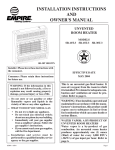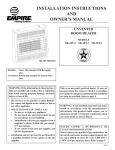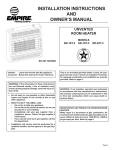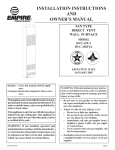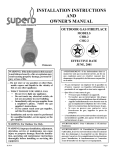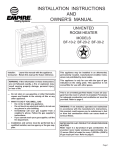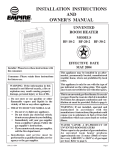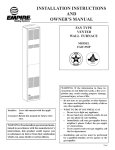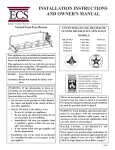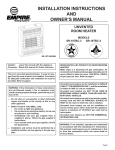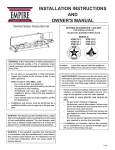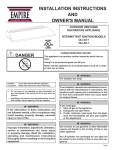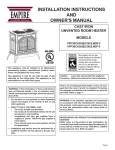Download Empire SR-6-3 Owner`s manual
Transcript
INSTALLATION INSTRUCTIONS AND OWNER’S MANUAL UNVENTED ROOM HEATER MODELS SR-6-3 SR-10-3 SR-18-3 SR-30-3 SR-30 SHOWN Installer: Leave this manual with the appliance. Consumer: Retain this manual for future reference. WARNING: If the information in these instructions are not followed exactly, a fire or explosion may result causing property damage, personal injury or loss of life. — Do not store or use gasoline or other flammable vapors and liquids in the vicinity of this or any other appliance. — WHAT TO DO IF YOU SMELL GAS • Do not try to light any appliance. • Do not touch any electrical switch; do not use any phone in your building. • Immediately call your gas supplier from a neighbor’s phone. Follow the gas supplier’s instructions. • If you cannot reach your gas supplier, call the fire department. — Installation and service must be performed by a qualified installer, service agency or the gas supplier. This appliance may be installed in an aftermarket, permanently located, manufactured (mobile) home, where not prohibited by local codes. This appliance is only for use with the type of gas indicated on the rating plate. This appliance is not convertible for use with other gases. This is an unvented gas-fired heater. It uses air (oxygen) from the room in which it is installed. Provisions for adequate combustion and ventilation air must be provided. Refer to page 6. WARNING: If not installed, operated and maintained in accordance with the manufacturer’s instructions, this product could expose you to substances in fuel or from fuel combustion which can cause death or serious illness. WATER VAPOR: A BY-PRODUCT OF UNVENTED ROOM HEATERS Water vapor is a by-product of gas combustion. An unvented room heater produces approximately one (1) ounce (30ml) of water for every 1,000 BTU’s (.3KW’s) of gas input per hour. Refer to page 6. Page 1 Table of Contents SECTION PAGE Important Safety Information................................................................................ 3 Safety Information for Users of LP Gas................................................................ 4 Introduction............................................................................................................ 5 Specifications......................................................................................................... 5 Water Vapor: A By-Product of Unvented Room Heaters....................................... 6 Provisions for Adequate Combustion and Ventilation Air..................................... 6 Gas Supply............................................................................................................. 7 SR-6 Clearances..................................................................................................... 8 SR-10 Clearances.............................................................................................. 8 - 9 SR-18 Clearances................................................................................................... 9 SR-30 Clearances................................................................................................. 10 Wall Mount Installation................................................................................ 10 - 11 Optional Floor Stand Installation......................................................................... 12 Lighting Instructions............................................................................................ 13 Main Burner Flame Characteristics..................................................................... 14 Pilot Flame Characteristics.................................................................................. 15 Main Burner Operation........................................................................................ 15 Appliance Maintenance....................................................................................... 16 Troubleshooting................................................................................................... 17 Parts Lists...................................................................................................... 18 - 19 SR-6 Parts View................................................................................................... 20 SR-10 Parts View................................................................................................. 21 SR-18 Parts View................................................................................................. 22 SR-30 Parts View................................................................................................. 23 Optional Blower Installation Instructions..................................................... 24 - 26 Master Parts Distributor List................................................................................ 27 How To Order Repair Parts.................................................................................. 27 Page 2 16942-7-1009 IMPORTANT SAFETY INFORMATION This Is a Heating Appliance Do Not Operate This Appliance Without Front Panel Installed. • An unvented room heater having an input rating of more than 6,000 Btu per hour shall not be installed in a bathroom. • An unvented room heater having an input rating of more than 10,000 Btu per hour shall not be installed in a bedroom or bathroom. • Due to high temperatures, the appliance should be located out of traffic and away from furniture and draperies. • Children and adults should be alerted to the hazard of high surface temperature and should stay away to avoid burns or clothing ignition. • service person. The appliance should be inspected before use and at least annually by a professional service person. More frequent cleaning may be required due to excessive lint from carpeting, bedding materials, etc. It is imperative that control compartments, burners and circulating air passageways of the appliance be kept clean. • Do not use this room heater if any part has been under water. Immediately call a qualified service technician to inspect the room heater and to replace any part of the control system and any gas control which has been under water. Young children should be carefully supervised when they are in the same room with the appliance. • • Do not place clothing or other flammable material on or near the appliance. • Due to high surface temperatures, keep children, clothing and furniture away. Warning: Any change to this HEATER or its controlS can be dangerous. Any safety screen or guard removed for servicing an appliance must be replaced prior to operating the heater. • • WARNING: Do not use a blower insert, heat exchanger insert or other accessory not approved for use with heater. Keep appliance area clear and free from combustible materials, gasoline and other flammable vapors and liquids. • WARNING: Failure to keep the primary air opening(s) of the burner(s) clean may result in sooting and property damage. • Installation and repair should be done by a qualified warning When used without adequate combustion and ventilation air, heater may give off CARBON MONOXIDE, an odorless, poisonous gas. Do not install heater until all necessary provisions are made for combustion and ventilation air. Consult the written instructions provided with the heater for information concerning combustion and ventilation air. In the absence of instructions, refer to the National Fuel Gas Code, ANSI Z223.1/NFPA 54, Air for Combustion and Ventilation, or applicable local codes. This heater is equipped with a pilot light safety system designed to turn off the heater if not enough fresh air is available. Do NOT TAMPER WITH PILOT LIGHT SAFETY SYSTEM! If heater shuts off, do not relight until you provide fresh air. Carbon monoxide poisoning may lead to death. Early signs of carbon monoxide poisoning resemble the flu, with headache, dizziness and/or nausea. If you have these signs, heater may not be working properly. Get fresh air at once! Have heater serviced. Some people — pregnant women, persons with heart or lung disease, anemia, those under the influence of alcohol, those at high altitudes — are more affected by carbon monoxide than others. The pilot light safety system senses the depletion of oxygen at its location. If this heater is installed in a structure having a high vertical dimension, the possibility exists that the oxygen supply at the higher levels will be less than that at the heater. In this type of application, a fan to circulate the structure air will minimize this effect. The use of this fan will also improve the comfort level in the structure. When a fan is used to circulate air, it should be located so that the air flow is not directed at the burner. If heater keeps shutting off, have it serviced. Keep burner and control compartment clean. 16942-7-1009 Page 3 SAFETY INFORMATION FOR USERS OF LP-GAS Propane (LP-Gas) is a flammable gas which can cause fires and explosions. In its natural state, propane is odorless and colorless. You may not know all the following safety precautions which can protect both you and your family from an accident. Read them carefully now, then review them point by point with the members of your household. Someday when there may not be a minute to lose, everyone's safety will depend on knowing exactly what to do. If, after reading the following information, you feel you still need more information, please contact your gas supplier. LP-GAS WARNING ODOR If a gas leak happens, you should be able to smell the gas because of the odorant put in the LP-Gas. That's your signal to go into immediate action! • Do not operate electric switches, light matches, use your phone. Do not do anything that could ignite the gas. • Get everyone out of the building, vehicle, trailer, or area. Do that IMMEDIATELY. • Close all gas tank or cylinder supply valves. • LP-Gas is heavier than air and may settle in low areas such as basements. When you have reason to suspect a gas leak, keep out of basements and other low areas. Stay out until firefighters declare them to be safe. • Use your neighbor's phone and call a trained LP-Gas service person and the fire department. Even though you may not continue to smell gas, do not turn on the gas again. Do not re-enter the building, vehicle, trailer, or area. • Finally, let the service man and firefighters check for escaped gas. Have them air out the area before you return. Properly trained LP-Gas service people should repair the leak, then check and relight the gas appliance for you. no odor detected - odor fade Some people cannot smell well. Some people cannot smell the odor of the chemical put into the gas. You must find out if you can smell the odorant in propane. Smoking can decrease your ability to smell. Being around an odor for a time can affect your sensitivity or ability to detect that odor. Sometimes other odors in the area mask the gas odor. People may not smell the gas odor or their minds are on something else. Thinking about smelling a gas odor can make it easier to smell. The odorant in LP-gas is colorless, and it can fade under some circumstances. For example, if there is an underground leak, the movement of the gas through soil can filter the odorant. Odorants in LP-Gas also are subject to oxidation. This fading can occur if there is rust inside the storage tank or in iron gas pipes. The odorant in escaped gas can adsorb or absorb onto or into walls, masonry and other materials and fabrics in a room. That will take some of the odorant out of the gas, reducing its odor intensity. LP-Gas may stratify in a closed area, and the odor intensity could vary at different levels. Since it is heavier than air, there may be more odor at lower levels. Always be sensitive to the slightest gas odor. If you detect any odor, treat it as a serious leak. Immediately go into action as instructed earlier. some points to remember • Learn to recognize the odor of LP-gas. Your local LP-Gas Dealer can give you a "Scratch and Sniff" pamphlet. Use it to find out what the propane odor smells like. If you suspect that your LP-Gas has a weak or abnormal odor, call your LP-Gas Dealer. • If you are not qualified, do not light pilot lights, perform service, or make adjustments to appliances on the LP-Gas system. If you are qualified, consciously think about the odor of LP-Gas prior to and while lighting pilot lights or performing service or making adjustments. • Sometimes a basement or a closed-up house has a musty smell that can cover up the LP-Gas odor. Do not try to light pilot lights, perform service, or make adjustments in an area where the conditions are such that you may not detect the odor if there has been a leak of LP-Gas. • Odor fade, due to oxidation by rust or adsorption on walls of new cylinders and tanks, is possible. Therefore, people should be particularly alert and careful when new tanks or cylinders are placed in service. Odor fade can occur in new tanks, or Page 4 reinstalled old tanks, if they are filled and allowed to set too long before refilling. Cylinders and tanks which have been out of service for a time may develop internal rust which will cause odor fade. If such conditions are suspected to exist, a periodic sniff test of the gas is advisable. If you have any question about the gas odor, call your lp-gas dealer. A periodic sniff test of the lp-gas is a good safety measure under any condition. • If, at any time, you do not smell the LP-Gas odorant and you think you should, assume you have a leak. Then take the same immediate action recommended above for the occasion when you do detect the odorized LP-Gas. • If you experience a complete "gas out," (the container is under no vapor pressure), turn the tank valve off immediately. If the container valve is left on, the container may draw in some air through openings such as pilot light orifices. If this occurs, some new internal rusting could occur. If the valve is left open, then treat the container as a new tank. Always be sure your container is under vapor pressure by turning it off at the container before it goes completely empty or having it refilled before it is completely empty. 16942-7-1009 INTRODUCTION Instructions to Installer 1. Installer must leave instruction manual with owner after installation. 2. Installer must have owner fill out and mail warranty card supplied with unvented room heater. 3. Installer should show owner how to start and operate unvented room heater. Always consult your local Building Department regarding regulations, codes or ordinances which apply to the installation of an unvented room heater. This appliance may be installed in an aftermarket* permanently located, manufactured (mobile) home, where not prohibited by state or local codes. *Aftermarket: Completion of sale, not for purpose of resale, from the manufacturer. This appliance is only for use with the type of gas indicated on the rating plate. This appliance is not convertible for use with other gases. General Information This appliance is design certified in accordance with American National Standards Institute Z21.11.2 by the Canadian Standards Association Laboratories as an Unvented Room Heater and shall be installed according to these instructions. Any alteration of the original design, installed other than as shown in these instructions or use with a type of gas not shown on the rating plate is the responsibility of the person and company making the change. WARNING: This appliance is equipped for (natural gas or propane) gas. Field conversion is not permitted. Important All correspondence should refer to complete Model Number, Serial Number and type of gas. Contact the manufacturer or your gas company before changing spud/ orifice size. Qualified Installing Agency Installation and replacement of gas piping, gas utilization equipment or accessories and repair and servicing of equipment shall be performed only by a qualified agency. The term “qualified agency” means any individual, firm, corporation, or company that either in person or through a representative is engaged in and is responsible for (a) the installation, testing, or replacement of gas piping or (b) the connection, installation, testing, repair, or servicing of equipment; that is experienced in such work; that is familiar with all precautions required, and that has complied with all the requirements of the authority having jurisdiction. State of Massachusetts: The installation must be made by a licensed plumber or gas fitter in the Commonwealth of Massachusetts. Sellers of unvented propane or natural gas-fired supplemental room heaters shall provide to each purchaser a copy of 527 CMR 30 upon sale of the unit. In the State of Massachusetts, unvented propane and natural gas-fired space heaters shall be prohibited in bedrooms and bathrooms. The installation must conform with local codes or, in the absence of local codes, with the National Fuel Gas Code, ANSI Z223.1/NFPA54.* *Available from the American National Standards Institute, Inc., 11 West 42nd St., New York, N.Y. 10036. High Altitudes For altitudes/elevations above 2,000 feet (610m) ratings should be reduced at the rate of 4 percent for each 1,000 feet (305m) above sea level. Contact the manufacturer or your gas company before changing spud/orifice size. Well Head Gas Installations Some natural gas utilities use “well head” gas. This may affect the Btu output of the unit. Contact the gas company for the heating value. Specifications Model Input BTU/HR (KW/H) Five Plaques BTU/HR (KW/H) Three Plaques BTU/HR (KW/H) Two Plaques BTU/HR (KW/H) One Plaque (Nat. Gas) BTU/HR (KW/H) One Plaque (LP Gas) Height Width Depth Gas Inlet Accessories Blower Floor Stand* SR-6 — — — 6,000 (1.8) 6,000 (1.8) 22” (559mm) 11 7/8” (302mm) 6 1/2” (165mm) SR-10 — — — 10,000 (2.9) 10,000 (2.9) 22” (559mm) 11 7/8” (302mm) 6 1/2” (165mm) SR-18 — 18,000 (5.3) 12,000 (3.5) 6,700 (2) 6,700 (2) 22” (559mm) 18” (457mm) 6 1/2” (165mm) SR-30 30,000 (8.8) 18,000 (5.3) — 8,000 (2.3) 7,000 (2.1) 22” (559mm) 24 1/8” (613mm) 6 1/2” (165mm) 3/8” (10mm) 3/8” (10mm) 3/8” (10mm) 3/8” (10mm) — SRS-10 — SRS-10 SRB-18 SRS-18 SRB-30 SRS-30 * Floor stand can not be used in a bathroom or bedroom installation. SR-6 must be wall mounted in a bathroom or bedroom installation. * Floor stand can not be used in a bedroom installation. SR-10 must be wall mounted in a bedroom installation. The bathroom or bedroom must be an unconfined space. ANSI Z223.1/NFPA54 defines an unconfined space as “a space whose volume is not less than 50 cubic feet per 1,000 Btu per hour (4.8m3 per kw) of the aggregate input rating of all appliances installed in that space.” 16942-7-1009 Page 5 Water Vapor: A By-Product of Unvented Room Heaters Water vapor is a by-product of gas combustion. An unvented room heater produces approximately one (1) ounce (30ml) of water for every 1,000 BTU's (.3KW's) of gas input per hour. Unvented room heaters must be used as supplemental heat (a room) rather than a primary heat source (an entire house). In most supplemental heat applications, the water vapor does not create a problem. In most applications, the water vapor enhances the low humidity atmosphere experienced during cold weather. The following steps will help insure that water vapor does not become a problem. 1. Be sure the heater is sized properly for the application, including ample combustion air and circulation air. 2. If high humidity is experienced, a dehumidifier may be used to help lower the water vapor content of the air. 3. Do not use an unvented room heater as the primary heat source (an entire house). Provisions for Adequate Combustion & Ventilation Air Provisions for Adequate Combustion and Ventilation Air This heater shall not be installed in a confined space or unusually tight construction unless provisions are provided for adequate combustion and ventilation air. The National Fuel Gas Code, ANSI Z223.1 defines a confined space as a space whose volume is less than 50 cubic feet per 1,000 Btu per hour (4.8m3 per kw) of the aggregate input rating of all appliances installed in that space and an unconfined space as a space whose volume is not less than 50 cubic feet per 1,000 Btu per hour (4.8m3 per kw) of the aggregate input rating of all appliances installed in that space. Rooms communicating directly with the space in which the appliances are installed, through openings not furnished with doors, are considered a part of the unconfined space. The following example is for determining the volume of a typical area in which the SR-18 may be located and for determining if this area fits the definition of an unconfined space. The maximum input of the SR-18 is 18,000 Btu per hour. Based on the 50 cubic feet per 1,000 Btu per hour formula, the minimum area that is an unconfined space for installation of the SR-18 is 900 cubic feet, 50 cubic feet x 18 = 900 cubic feet. To determine the cubic feet of the area in which the SR-18 is to be installed, measure the length, width and height of the area. Example: The area measures 13 feet in length, 9 feet in width and 8 feet in height, the area is 936 cubic feet. The SR-18 can be installed in this unconfined space with no requirement to provide additional combustion and ventilation air. Page 6 Warning: If the area in which the heater may be operated is smaller than that defined as an unconfined space or if the building is of unusually tight construction, provide adequate combustion and ventilation air by one of the methods described in the National Fuel Gas Code, ANSI Z223.1/NFPA 54, Air for Combustion and Ventilation, or applicable local codes. Unusually Tight Construction The air that leaks around doors and windows may provide enough fresh air for combustion and ventilation. However, in buildings of unusually tight construction, you must provide additional fresh air. Unusually tight construction is defined as construction where: a. Walls and ceilings exposed to the outside atmosphere have a continuous water vapor retarder with a rating of one perm or less with openings gasketed or sealed, and b. Weatherstripping has been added on openable windows and doors, and c. Caulking or sealants are applied to areas such as joints around window and door frames, between sole plates and floors, between wall-ceiling joints, between wall panels, at penetrations for plumbing, electrical, and gas lines, and at other openings. If the heater is installed in a building of unusually tight construction, adequate air for combustion, ventilation and dilution of flue gases shall be provided in accordance with ANSI Z223.1/NFPA54. 16942-7-1009 gas supply The gas line can be routed either through the floor or wall. The gas line opening should be made at this time. Location of the opening will be determined by the position of floor joists and the valve and union used for servicing. Gas Supply Check all local codes for requirements, especially for the size and type of gas supply line required. Recommended Gas Pipe Diameter Pipe Length Schedule 40 Pipe Tubing, Type L Inside Diameter Outside Diameter Nat. L.P. Nat. L.P. 0-10 feet 1/2” 3/8” 1/2” 3/8” 0-3 meters 12.7mm 9.5mm 12.7mm 9.5mm 10-40 feet 1/2” 1/2” 5/8” 1/2” 4-12 meters 12.7mm 12.7mm 15.9mm 12.7mm 40-100 feet 1/2” 1/2” 3/4” 1/2” 13-30 meters 12.7mm 12.7mm 19mm 12.7mm 100-150 feet 3/4” 1/2” 7/8” 3/4” 31-46 meters 19mm 12.7mm 22.2mm 19mm Note: Never use plastic pipe. Check to confirm whether your local codes allow copper tubing or galvanized. Note: Since some municipalities have additional local codes, it is always best to consult your local authority and installation code. 3 9/16” (90mm) GAS INLET IN BOTTOM OF HEATER WALL 1 11/16” (43mm) TO WALL VIEW FROM TOP OF HEATER Dimensions Apply to SR-6, SR-10, SR-18 Figure 1 Installing a New Main Gas Cock Each appliance should have its own manual gas cock. A manual main gas cock should be located in the vicinity of the unit. Where none exists, or where its size or location is not adequate, contact your local authorized installer for installation or relocation. Compounds used on threaded joints of gas piping shall be resistant to the action of liquefied petroleum gases. The gas lines must be checked for leaks by the installer. This should be done with a soap solution watching for bubbles on all exposed connections, and if unexposed, a pressure test should be made. Never use an exposed flame to check for leaks. Appliance must be disconnected from piping at inlet of control valve and pipe capped or plugged for pressure test. Never pressure test with appliance connected; control valve will sustain damage! 16942-7-1009 A gas valve and ground joint union should be installed in the gas line upstream of the gas control to aid in servicing. It is required by the National Fuel Gas Code that a drip line be installed near the gas inlet. This should consist of a vertical length of pipe tee connected into the gas line that is capped on the bottom in which condensation and foreign particles may collect. Figure 2 Method of Installing a Tee Fitting Sediment Trap (Figure 2) The use of the following gas connectors is recommended: — ANS Z21.24 Appliance Connectors of Corrugated Metal Tubing and Fittings — ANS Z21.45 Assembled Flexible Appliance Connectors of Other Than All-Metal Construction The above connectors may be used if acceptable by the authority having jurisdiction. Pressure Testing of the Gas Supply System 1. To check the inlet pressure to the gas valve, a 1/8" (3mm) N.P.T. plugged tapping, accessible for test gauge connection, must be placed immediately upstream of the gas supply connection to the appliance. 2. The appliance and its appliance main gas valve must be disconnected from the gas supply piping system during any pressure testing of that system at test pressures in excess of 1/2 psig (3.5 kPa). 3. The appliance must be isolated from the gas supply piping system by closing its equipment shutoff valve during any pressure testing of the gas supply piping system at test pressures equal to or less than 1/2 psig (3.5 kPa). Attention! If one of the above procedures results in pressures in excess of 1/2 psig (14" w.c.) (3.5 kPa) on the appliance gas valve, it will result in a hazardous condition. Checking Manifold Pressure Natural gas will have a manifold pressure of approximately 6.0" w.c. (1.49kPa) at the pressure regulator outlet with the inlet pressure to the pressure regulator from a minimum of 7.0" w.c. (1.743kPa) for the purpose of input adjustment to a maximum of 10.5" w.c. (2.615kPa). Propane/LP gas will have a manifold pressure approximately 10.0" w.c. (2.49kPa) at the pressure regulator outlet with the inlet pressure to the pressure regulator from a minimum of 11.0" w.c. (2.739kPa) for the purpose of input adjustment to a maximum of 13.0" w.c. (3.237kPa). A test gage connection is located downstream of the gas appliance pressure regulator for measuring gas pressure. The connection is a 1/8 inch (3mm) N.P.T. plugged tapping. Page 7 SR-6 Clearances When facing the front of the appliance the following minimum clearances to combustible construction must be maintained. Left side 6 inches (152mm). Right side 6 inches 152mm). Do not install in alcove or closet. Rear wall 0 (0mm) inches. Ceiling 24 inches (610mm). Minimum vertical clearance from a projection above the appliance (shelves, window sills, etc.) 10 inches (254mm). Maximum horizontal extension of projection above the appliance 12 inches (305mm). Floor (top surface of carpeting, tile, etc.) 2 inches (51mm). Provide adequate clearances around air openings. Adequate accessibility clearances for purposes of servicing and proper operation must be provided. CEILING 24” MIN (610mm) CEILING WINDOW SILL OR SHELF SIDE WALL WINDOW SILL OR SHELF 10” MIN (254mm) 6” MIN (152mm) 12” MAX (305mm) 24” MIN (610mm) 10” MIN (254mm) 6” MIN (152mm) 0” (0mm) CLEARANCE TO REAR WALL SIDE VIEW 2” MIN (51mm) 2” MIN (51mm) FLOOR FLOOR Figure 3 (SR-6) Figure 4 (SR-6) SR-10 Clearances When facing the front of the appliance the following minimum clearances to combustible construction must be maintained. Left side 6 inches (152mm). Right side 6 inches (152mm). Do not install in alcove or closet. Rear wall 0 inches (0mm). Ceiling 24 inches (610mm). Minimum vertical clearance from a projection above the appliance (shelves, window sills, etc.) 14 inches (356mm). Maximum horizontal extension of projection above the appliance 12 inches (305mm). Floor (top surface of carpeting, tile, etc.) 2 inches (51mm). Provide adequate clearances around air openings. Adequate accessibility clearances for purposes of servicing and proper operation must be provided. Page 8 16942-7-1009 CEILING CEILING WINDOW SILL OR SHELF SIDE WALL 24” MIN (610mm) 12” MAX (305mm) 24” MIN (610mm) 14” MIN (356mm) 14” MIN 0” (0mm) CLEARANCE (356mm) TO REAR WALL 6” MIN (152mm) 6” MIN (152mm) SIDE VIEW 2” MIN (51mm) 2” MIN (51mm) FLOOR FLOOR Figure 5 (SR-10) Figure 6 (SR-10) SR-18 Clearances When facing the front of the appliance the following minimum clearances to combustible construction must be maintained. Left side 6 inches (152mm). Right side 6 inches (152mm). Do not install in alcove or closet. Rear wall 0 inches (0mm). Ceiling 36 inches (914mm). Minimum vertical clearance from a projection above the appliance (shelves, window sills, etc.) 36 inches (914mm). Floor (top surface of carpeting, tile, etc.) 2 inches (51mm). Provide adequate clearances around air openings. CEILING SIDE WALL 36” (914mm) MIN 6” (152mm) MIN 6” (152mm) MIN Adequate accessibility clearances for purposes of servicing and proper operation must be provided. 2” MIN (51mm) FLOOR Figure 7 (SR-18) 16942-7-1009 Page 9 SR-30 Clearances When facing the front of the appliance the following minimum clearances to combustible construction must be maintained. Left side 8 inches (203mm). Right side 8 inches (203mm). Do not install in alcove or closet. Rear wall 0 inches (0mm). Ceiling 36 inches (914mm). Minimum vertical clearance from a projection above the appliance (shelves, window sills, etc.) 36 inches (914mm). Floor (top surface of carpeting, tile, etc.) 2 inches (51mm). CEILING SIDE WALL 36” MIN 8” MIN. 8” MIN. Provide adequate clearances around air openings. Adequate accessibility clearances for purposes of servicing and proper operation must be provided. 2” MIN FLOOR Figure 8 (SR-30) WALL MOUNT INSTALLATION Refer to Figures 9, 10, 11 and 12 for measurements in order to locate (4) mounting holes on wall. Figures 9, 10, 11 and 12 are the front views of the heaters. 1. Remove lower louver from casing assembly (2 screws). 2. Remove reflector from casing assembly (2 screws). 3. Remove upper louver from casing assembly (2 screws). 11 13/16” (300mm) 11 13/16” (300mm) 1 3/32” 2” (28mm) (51mm) 7 13/16” (198mm) 1 3/32” 2” (28mm) (51mm) 2” (51mm) 18 7/8” (479mm) 22” (559mm) FLOOR 2” MIN (51mm) MOUNTING HOLE LOCATIONS VIEWED FROM FRONT OF HEATER Figure 9 (SR-6) Page 10 2” (51mm) 22” (559mm) 18 7/8” (479mm) OUTLINE OF OUTER CASING 4 1/32” (102mm) 7 13/16” (198mm) OUTLINE OF OUTER CASING 4 1/32” MIN (102mm) FLOOR 2” MIN (51mm) MOUNTING HOLE LOCATIONS VIEWED FROM FRONT OF HEATER Figure 10 (SR-10) 16942-7-1009 WALL MOUNT INSTALLATION (cont.) 18” (457mm) 14” (356mm) 1 3/32” (28mm) OUTLINE OF OUTER CASING 22” (559mm) 18 7/8” (479mm) 2 1/32” (52mm) 4 1/32” MIN (102mm) FLOOR 2” MIN (51mm) MOUNTING HOLE LOCATIONS VIEWED FROM FRONT OF HEATER Figure 11 (SR-18) 24 1/8” (613mm) 2” (51) 20 1/8” (511mm) On Solid Wall 1. After locating mounting holes, attach (4) #10 x 1" (25mm) screws provided into the wall. Do not completely tighten screwheads to the wall, leave a 1/8" (3mm) gap between screwheads and wall. 2. Mount heater onto the (4) screwheads and complete tightening screwheads into the wall. Attention! Use the following steps to properly align the upper louver and the reflector with the heat shield. a. When replacing upper louver, be sure the bottom lip of upper louver goes behind the heat shield. b. When replacing reflector, be sure the top lip of reflector goes in front of the heat shield. 3. Connect the gas line. On Sheet Rock Wall 1. After locating mounting holes, drill (4) 5/16" (8mm) diameter holes into the wall. 2. Insert (4) plastic expansion anchors provided into the holes. 3. Tighten (4) #10 x 1" (25mm) screws provided into the plastic expansion anchors. Do not completely tighten screwheads to the plastic expansion anchors, leave a 1/8" (3mm) gap between screwheads and plastic expansion anchors. 4. Mount heater onto the (4) screwheads and complete tightening the screwheads to the plastic expansion anchors. Attention! Use the following steps to properly align the upper louver and the reflector with the heat shield. a. When replacing upper louver, be sure the bottom lip of upper louver goes behind the heat shield. b. When replacing reflector, be sure the top lip of reflector goes in front of the heat shield. 5. Connect the gas line. 2” (51) 1 3/32” (28mm) 18 7/8” (479mm) 4 1/32” (102mm) MIN 22” (559mm) 2 1/32” (52mm) 2” (51mm)MIN Figure 12 (SR-30) Figure 13 16942-7-1009 Page 11 Optional Floor Stand installation 1. Align clearance holes on floor stand with screw holes on bottom of heater, as shown in Figure 14. 2. Attach floor stand to heater with (4) screws provided with floor stand. 3. Connect the gas line. *Floor stand can not be used in a bathroom or bedroom installation. SR-6 must be wall mounted in a bathroom or bedroom installation. *Floor stand can not be used in a bedroom installation. SR-10 must be wall mounted in a bedroom installation. Installation on Rugs and Tile If this appliance is installed directly on carpeting, tile or other combustible material, other than wood flooring, the appliance shall be installed on a metal or wood panel extending the full width and depth of the appliance. Attention: Optional Floor Stand meets requirement. The base referred to above does not mean the fire-proof base as used on wood stoves. The protection is for rugs that are extremely thick and light colored tile. SR-30 Shown Figure 14 Page 12 16942-7-1009 Lighting Instructions FOR YOUR SAFETY READ BEFORE LIGHTING Warning: If you do not follow these instructions exactly, a fire or explosion may result causing property damage, personal injury or loss of life. A. This appliance has a pilot which must be lighted by hand. When lighting the pilot, follow these instructions exactly. B. Before lighting smell all around the appliance area for gas. Be sure to smell next to the floor because some gas is heavier than air and will settle on the floor. What To Do If You Smell Gas •Do not try to light any appliance. •Do not touch any electrical switch; Do not use any phone in your building. •Immediately call your gas supplier from a neighbor's phone. Follow the gas supplier's instructions. •If you cannot reach your gas supplier, call the fire department. C. Use only your hand to push in or turn the gas control knob. Never use tools. If the knob will not push in or turn by hand, don't try to repair it; call a qualified service technician. Force or attempted repair may result in a fire or explosion. D. Do not use this appliance if any part has been under water. Immediately call a qualified service technician to inspect the appliance and to replace any part of the control system and any gas control which has been under water. Lighting Instructions 1. STOP! Read the safety information above. 2. Turn off all electric power to the appliance (if applicable). 3. Push in manual gas control knob slightly and turn clockwise to “OFF”. Do not force. SR-18 OR SR-30 KNOB SHOWN. 4. Wait ten (10) minutes to clear out any gas. Then smell for gas, including near the floor. If you smell gas, STOP! Follow “B” in the safety information above. If you don’t smell gas, go to the next step. 5. Find pilot - the pilot is attached at the bottom of the burner assembly . 6. Turn manual gas control knob counterclockwise to "PILOT." 7. Push in manual gas control knob all the way and hold in. Repeatedly push the piezo ignitor button until pilot is lit (or use a match to light pilot). Continue to hold the control knob in for about one (1) minute after the pilot is lit. Release knob and it will pop back up. Pilot should remain lit. If it goes out, repeat steps 3 through 7. • If knob does not pop up when released, stop and immediately call your service technician or gas supplier. • If the pilot will not stay lit after several tries, turn the gas control knob to “OFF” and call your service technician or gas supplier. 8. Three heat settings can be selected by slightly depressing the manual gas control knob and turning the manual gas control to: knob counterclockwise Position 1 (SR-6, SR-10, SR-18 or SR-30) Position 2 (SR-18 or SR-30) Position 3 (SR-18 or SR-30). 9. CAUTION! When the manual gas control knob has been turned to desired heat setting, ensure the manual gas control knob is locked into that heat setting and cannot be turned without being depressed. If the manual gas control knob is in mid-position, between heat settings, incomplete combustion will take place, causing odor, and may produce gas leakage or carbon monoxide. 10. Turn on all electric power to appliance (if applicable). To Turn Off Gas To Appliance 1. Turn off all electric power to appliance if service is to be performed (if applicable). 16942-7-1009 2. Push in manual gas control knob slightly and turn clockwise to "OFF". Do not force. Page 13 Main Burner Flame Characteristics SR-6 Main Burner Flame (Figure 15) The main burner flame will have a red-orange glow over the surface of the ceramic plaque. The red-orange glow on the surface of the ceramic plaque will have a pattern in the shape of a number 1. The perimeter of the ceramic plaque [approximately the outside 1/4"(6mm)] will not glow. A few small, hairline cracks may form over the surface of the ceramic plaques or at the edges of the ceramic plaques where they have been cemented into position on the burner assembly frame. These small, hairline cracks will not affect the operation or performance of the ceramic plaques. Only, when large cracks develop, with blue flames escaping from the large cracks, should you contact your QUALIFIED SERVICE PERSON. 13. Apply air pressure into ceramic plaque(s) to remove dust, lint or spider webs. 14. As parts are being replaced in reverse order, check for gas leaks at all gas connections before lower louver is replaced onto casing assembly. SR-10, SR-18 and SR-30 Main Burner Flame (Figure 16) The main burner flame will have a red-orange glow over the surface of the ceramic plaques. A few small, hairline cracks may form over the surface of the ceramic plaques or at the edges of the ceramic plaques where they have been cemented into position on the burner assembly frame. These small, hairline cracks will not affect the operation or performance of the ceramic plaques. Only, when large cracks develop, with blue flames escaping from the large cracks, should you contact your QUALIFIED SERVICE PERSON. A red-orange haze that is visible on the ceramic plaques is acceptable. A blue flame that rolls out at the top of the ceramic plaques indicates an accumulation of dust, lint or spider webs inside the casing assembly and main burner assembly. Use the following procedure to inspect the casing assembly and main burner assembly. 1. Turn OFF gas supply to the heater. 2. Turn OFF electric supply to the heater if optional blower is installed in heater. 3. Remove lower louver from casing assembly ( 2 screws). 4. Remove reflector from casing assembly (2 screws). 5. Inspect interior of casing assembly for accumulation of dust, lint or spider webs. If necessary, clean interior of casing assembly with a vacuum cleaner or apply air pressure. Do not damage any components within casing assembly when you are cleaning. 6. Remove pilot bracket from main burner assembly (2 screws). 7. Pivot pilot bracket with attached pilot away from main burner assembly (do not damage pilot tubing). 8. Inspect main burner orifice(s) through the rectangular opening(s) in the venturi (throat) of the main burner(s). Dust, lint and spider webs can accumulate on top of the main burner orifice(s). If necessary, clean main burner orifice(s) with a vacuum cleaner or apply air pressure. To thoroughly clean the main burner orifice(s) proceed to Step 9. 9. Disconnect supply tubing from orifice holder(s). 10. Remove orifice holder from venturi of main burner assembly (1 screw for each orifice holder). 11. Remove main burner orifice from orifice holder. 12. Apply air pressure through main burner orifice and orifice holder to remove dust, lint or spider webs. Page 14 SR-6 Figure 15 SR-30 Shown Figure 16 16942-7-1009 Pilot Flame Characteristics The correct flame will be blue and will extend beyond the thermocouple. The flame will surround the thermocouple just below the tip. A slight yellow flame may occur where the pilot flame and main burner flame meet. 2. Blow air pressure through the holes indicated by the arrows. This will blow our foreign materials such as dust, lint and spider webs. Tighten nut B also by grasping nut A. Figure 17 Oxygen Depletion Sensor Pilot (Figure 16) When the pilot has a large yellow tip flame, clean the Oxygen Depletion Sensor as follows: 1. Clean the ODS pilot by loosening nut B from the pilot tubing. When this procedure is required, grasp nut A with an open end wrench. Figure 18 Warning: Never use needles, wires, or similar cylindrical objects to clean the pilot to avoid damaging the calibrated ruby that controls the gas flow. Main Burner Operation The main burner operation is MANUAL. The owner must manually place the main burner in operation. The owner will either select one, three or five plaques to be in operation. Once the owner has turned the main burner ON, it will continue to operate until the owner manually turns the main burner OFF. Description of Manual Gas Control Knob: OFF position. PILOT position. SR-6 Position 1 Will have one plaque in operation, the input will be 6,000 Btuh (1.8KW/H). SR-10 Position 1 Will have one plaque in operation, the input will be 10,000 Btuh(2.9KW/H). 16942-7-1009 SR-18 Position 1 Will have one plaque in operation, the input will be 6,700 Btuh (2KW/H). Position 2 Will have two plaques in operation, the input will be 12,000 BTUH (3.5KW/H). Position 3 Will have three plaques in operation, the input will be 18,000 BTUH (5.3KW/H). SR-30 Position 1 Will have one plaque in operation, the input will be 8,000 BTUH (2.3KW/H) for Natural gas and 7,000 Btuh (2.1KW/H) for Propane/LP gas. Position 2 Will have three plaques in operation, the input will be 18,000 BTUH (5.3KW/H). Position 3 Will have five plaques in operation, the input will be 30,000 BTUH (8.8KW/H). Page 15 Appliance Maintenance Removing Pilot/Thermocouple From Main Burner Assembly Attention: The thermocouple CAN NOT be replaced as an individual item. You must order a new pilot when replacing thermocouple. 1. Turn OFF gas supply to the heater. 2. Turn OFF electrical supply to the heater if optional blower is installed in heater. 3. Remove lower louver from casing assembly (2 screws). 4. Remove reflector from casing assembly (2 screws). 5. Disconnect pilot tubing from pilot (see Figure 18, Page 15). Grasp nut A with a wrench when removing nut B with a second wrench. 6. Remove pilot from pilot bracket (2 screws). 7. Remove thermocouple lead from gas valve. 8. As parts are being replaced in reverse order, check for gas leaks at all gas connections before lower louver is replaced onto casing assembly. Removing Main Burner Orifice(s) From Main Burner Assembly 1. Turn off gas supply to the heater. 2. Turn off electrical supply to the heater if optional blower is installed in heater. 3. Remove lower louver from casing assembly (2 screws). 4. Remove reflector from casing assembly (2 screws). 5. Remove pilot bracket from main burner assembly (2 screws). 6. Pivot pilot bracket with attached pilot away from main burner assembly (do not damage pilot tubing). 7. Disconnect supply tubing from orifice holder(s). 8. Remove orifice holder from venturi of main burner assembly (1 screw for each orifice holder). 9. Remove main burner orifice from orifice holder. Attention: The number stamped on the main burner orifice is a millimeter diameter. 10. As parts are being replaced in reverse order, check for gas leaks at all gas connections before lower louver is replaced onto casing assembly. Removing Manual Gas Control From Casing Assembly 1. Turn off gas supply to the heater. 2. Turn off electrical supply to the heater if optional blower is installed in heater. 3. Remove lower louver from casing assembly (2 screws). 4. Remove reflector from casing assembly (2 screws). 5. Disconnect inlet supply tubing, outlet supply tubing, pilot supply tubing and thermocouple lead from manual gas control. 6. If heater is attached to wall, disconnect gas supply line from inlet regulator. 7. Remove heater from wall. 8. Remove cotter pin from manual gas control rod. 9. Remove manual gas control bracket from casing assembly (3 screws to be removed are located on casing assembly back). 10. Loosen nut that secures manual gas control to bracket. Remove manual gas control from bracket. 11. As parts are being replaced in reverse order, check for gas leaks at all gas connections before reflector and lower louver are replaced onto casing assembly. Removing Main Burner From Casing Assembly 1. Turn off gas supply to the heater. 2. Turn off electrical supply to the heater if optional blower is installed in heater. 3. Remove lower louver from casing assembly (2 screws). 4. Remove reflector from casing assembly (2 screws). 5. Disconnect supply tubing from orifice holder(s). 6. Remove pilot bracket from main burner assembly (2 screws). 7. Remove main burner assembly from casing assembly (4 screws). 8. Remove orifice shield from main burner assembly. Attach orifice shield to new main burner assembly. 9. As parts are being replaced in reverse order, check for gas leaks at all gas connections before lower louver is replaced onto casing assembly. Piezo Pilot Ignitor Instructions Depressing the ignitor button completely causes a spark to occur at the pilot. To light the pilot, it is important that the electrode be 1/8" (3mm) from the pilot. The spark must occur at the point the pilot flame hits the thermocouple. On a new installation with air in the gas line, it is suggested that a match be used. The match will light the pilot faster than the piezo under this condition. Page 16 16942-7-1009 troubleshooting 1. Spark electrode does not produce spark. a. Spark electrode broken - replace. b. Ignitor wire may not be attached to spark electrode attach. c. Ignitor wire damaged - replace. d. Piezo ignitor defective - replace. 2. Spark electrode produces spark but pilot does not light. a.No gas to heater - turn on gas. b. PILOT position not properly aligned - turn gas control knob to Pilot position and depress. c. Pilot is blocked from spider web or dirt - clean pilot, see Page 15. 4. Main burner does not ignite. a. Main burner orifice is blocked - clean, see "Main Burner Flame Characteristics," Page 14. Attention: The number stamped on the main burner orifice is a millimeter diameter. b. Inlet gas pressure too low, contact gas supplier. 5. Heater keeps shutting "OFF" during normal operation. a. Pilot is blocked - clean pilot, see Page 15. b. Inlet gas pressure too low, contact gas supplier 3. Pilot flame does not stay "ON" when control knob is released. a. Control knob in pilot position not completely depressed or held in long enough. b. Thermocouple not tightened into gas control - tighten thermocouple. c. Pilot flame not surrounding thermocouple - clean pilot, see Page 15. d. Inlet gas pressure too low, contact gas supplier. e. Thermocouple defective - replace. f. Gas control defective - replace. 16942-7-1009 Page 17 parts list Index No. 1 2 3 4 5 6 7 8 8 9 Part No. 13344 R-2313 R-2328 SR-036 SR-126 SR-008 SR-153 SR-032 SR-250 R-6308 9 R-6307 10 11 12 13 14 15 16 R-6309 R-6310 SR-143 SR-112 R-2277 SR-139 SR-221 17 17 18 19 20 20 21 22 23 24 25 26 NS NS R-5097 R-5098 10753 R-2314 R-2319 R-2320 R-2332 R-2305 SR-134 SR-129 SR-135 SRS-10 R-2390 SR-216 SR-6 Description CASING SIDE ASSEMBLY – LEFT PIEZO IGNITOR CONTROL KNOB CONTROL ROD CASING BACK CASING SIDE ASSEMBLY – RIGHT ORIFICE SHIELD PILOT BRACKET (NAT) PILOT BRACKET (LPG) PILOT ASSEMBLY (LPG ONLY) (INCLUDES ITEM 10 & 11) PILOT ASSEMBLY (NAT ONLY) (INCLUDES ITEM 10 & 11) SPARK IGNITOR PILOT THERMOCOUPLE TUBING – GAS VALVE TO PILOT VALVE BRACKET GAS VALVE – COPRECI TUBING – GAS VALVE TO BURNER TUBING – INLET REGULATOR TO GAS VALVE INLET REGULATOR – NAT INLET REGULATOR – LPG INLET REGULATOR BRACKET ORIFICE HOLDER MAIN BURNER ORIFICE – NAT MAIN BURNER ORIFICE – LPG BURNER CHROME GRILL CASING LOUVER (2 REQUIRED) REFLECTOR ASSEMBLY HEAT SHIELD OPTIONAL FLOOR STAND KIT IGNITOR WIRE HARDWARE PACKAGE Index No. 1 2 3 4 5 6 7 8 8 9 Part No. 13345 R-2313 R-2328 SR-036 SR-177 SR-008 R-153 SR-179 SR-032 R-6308 9 R-6307 10 11 12 13 14 15 16 R-6309 R-6310 SR-143 SR-112 R-2277 SR-139 SR-221 17 17 18 19 20 20 21 22 23 24 25 26 NS NS R-5097 R-5098 10753 R-2314 R-2317 R-2476 R-2331 R-2305 SR-134 R-129 R-135 SRS-10 R-2390 SR-216 SR-10 Description CASING SIDE ASSEMBLY – LEFT PIEZO IGNITOR CONTROL KNOB CONTROL ROD CASING BACK CASING SIDE ASSEMBLY – RIGHT ORIFICE SHIELD PILOT BRACKET (NAT) PILOT BRACKET (LPG) PILOT ASSEMBLY (LPG ONLY) (INCLUDES ITEMS 10 & 11) PILOT ASSEMBLY (NAT ONLY) (INCLUDES ITEMS 10 & 11) SPARK IGNITOR PILOT THERMOCOUPLE TUBING – GAS VALVE TO PILOT VALVE BRACKET GAS VALVE – COPRECI TUBING – GAS VALVE TO BURNER TUBING – INLET REGULATOR TO GAS VALVE INLET REGULATOR – NAT INLET REGULATOR – LPG INLET REGULATOR BRACKET ORIFICE HOLDER MAIN BURNER ORIFICE – NAT MAIN BURNER ORIFICE – LPG BURNER CHROME GRILL CASING LOUVER (2 REQUIRED) REFLECTOR ASSEMBLY HEAT SHIELD OPTIONAL FLOOR STAND KIT IGNITOR WIRE HARDWARE PACKAGE USE ONLY MANUFACTURER’S REPLACEMENT PARTS. USE OF ANY OTHER PARTS COULD CAUSE INJURY OR DEATH. Page 18 16942-7-1009 parts list SR-30 SR-18 INDEX NO. PART NO. DESCRIPTION INDEX NO. PART NO. DESCRIPTION 1 2 3 4 5 6 7 8 9 13346 SR-068 R-2313 R-2324 SR-036 SR-008 SR-119 SR-032 R-6307 1 2 3 4 5 6 7 8 9 13346 SR-004 R-2313 R-2324 SR-036 SR-008 SR-114 SR-032 R-6307 9 R-6308 9 R-6308 10 11 12 13 14 15 R-6309 R-6310 SR-086 SR-022 R-1649 SR-081 16 SR-083 17 18 R-2314 R-2315 10 11 12 13 14 15 16 17 18 19 20 R-6309 R-6310 SR-037 SR-022 R-1649 SR-023 SR-027 R-2310 SR-028 R-2314 R-2315 18 R-2498 20 R-2498 19 20 R-2330 SR-082 21 SR-217 21 22 23 23 24 R-2329 10753 R-5097 R-5098 SR-215 22 23 23 24 25 26 10753 R-5097 R-5098 R-2304 SR-076 SR-070 25 SR-029 26 SR-024 27 28 SR-077 SR-120 29 SR-121 CASING SIDE ASSEMBLY - LEFT CASING BACK PIEZO IGNITOR CONTROL KNOB CONTROL ROD CASING SIDE ASSEMBLY -RIGHT ORIFICE SHIELD PILOT BRACKET PILOT ASSEMBLY (NAT ONLY) (INCLUDES ITEMS 10 & 11) PILOT ASSEMBLY (LPG ONLY) (INCLUDES ITEMS 10 & 11) SPARK IGNITOR PILOT THERMOCOUPLE TUBING - GAS VALVE TO PILOT VALVE BRACKET GAS VALVE - COPRECI TUBING - GAS VALVE TO BURNER ONE TUBING - GAS VALVE TO BURNER THREE ORIFICE HOLDER (3 REQUIRED) MAIN BURNER ORIFICE - NAT (3 REQUIRED) MAIN BURNER ORIFICE - LPG (3 REQUIRED) BURNER TUBING - GAS VALVE TO BURNER TWO TUBING - INLET REGULATOR TO GAS VALVE INLET REGULATOR BRACKET INLET REGULATOR - NAT INLET REGULATOR - LPG CHROME GRILL CASING LOUVER (2 REQUIRED) REFLECTOR ASSEMBLY WITH REAR SHIELD HEAT SHIELD OPTIONAL SRS-18 FLOOR STAND KIT OPTIONAL SRB-18 BLOWER KIT (INCLUDES 29 THROUGH 36) BRASS BUSHING (4 REQUIRED) RUBBER GROMMET (4 REQUIRED) BLOWER PAN CORD SET ASSEMBLY BUSHING - HEYCO #SR5KN4 WIRE ASSEMBLY ON/OFF SWITCH BLOWER (INCLUDES MOTOR BLOWER HARDWARE PACKAGE IGNITOR WIRE HARDWARE PACKAGE 27 28 29 30 31 32 33 SR-026 R-2303 SR-017 SR-009 SR-018 SR-115 SR-118 CASING SIDE ASSEMBLY - LEFT CASING BACK PIEZO IGNITOR CONTROL KNOB CONTROL ROD CASING SIDE ASSEMBLY -RIGHT ORIFICE SHIELD PILOT BRACKET PILOT ASSEMBLY (NAT ONLY) (INCLUDES ITEMS 10 & 11) PILOT ASSEMBLY (LPG ONLY) (INCLUDES ITEMS 10 & 11) SPARK IGNITOR PILOT THERMOCOUPLE TUBING - GAS VALVE TO PILOT ALVE BRACKET GAS VALVE - COPRECI TUBING - GAS VALVE TO TEE TUBING - TEE TO BURNER FOUR TEE - (2 REQUIRED) TUBING - TEE TO BURNER TWO ORIFICE HOLDER (5 REQUIRED) MAIN BURNER ORIFICE - NAT (5 REQUIRED) MAIN BURNER ORIFICE - LPG (5 REQUIRED) BURNER INLET REGULATOR BRACKET INLET REGULATOR - NAT INLET REGULATOR - LPG TUBING - INLET REGULATOR TO GAS VALVE TUBING - GAS VALVE TO BURNER THREE TUBING - TEE TO BURNER ONE & FIVE (2 REQUIRED) TUBING - GAS VALVE TO TEE HROME GRILL CASING LOUVER (2 REQUIRED) REFLECTOR ASSEMBLY HEAT SHIELD OPTIONAL SRS-30 FLOORSTAND KIT OPTIONAL SRB-30 BLOWER KIT (INCLUDES 33 THROUGH 40) BRASS BUSHING (4 REQUIRED) RUBBER GROMMET (4 REQUIRED) BLOWER PAN CORD SET ASSEMBLY BUSHING - HEYCO #SR5KN4 WIRE ASSEMBLY ON/OFF SWITCH LOWER (INCLUDES MOTOR BLOWER HARDWARE PACKAGE IGNITOR WIRE HARDWARE PACKAGE 30 R-1454 31 R-1499 32 SR-195 33 VF-068 34 R-1468 35 R-2395 36 R-2522 37 R-2396 NOT SHOWN SR-218 NOT SHOWN R-2390 NOT SHOWN SR-216 34 R-1454 35 R-1499 36 SR-197 37 VF-068 38 R-1468 39 R-2395 40 R-2522 41 R-2396 NOT SHOWN SR-218 NOT SHOWNSR-2390 NOT SHOWN SR-216 USE ONLY MANUFACTURER’S REPLACEMENT PARTS. USE OF ANY OTHER PARTS COULD CAUSE INJURY OR DEATH. 16942-7-1009 Page 19 SR-6 parts View Page 20 16942-7-1009 SR-10 parts View 16942-7-1009 Page 21 SR-18 parts View Page 22 16942-7-1009 SR-30 parts View 16942-7-1009 Page 23 Optional blower installation instructions OPTIONAL BLOWERS SRB-18 and SRB-30 for Unvented Room Heaters SR-18 and SR-30 INSTALLING OPTIONAL BLOWER SRB-18 OR SRB-30 If heater is installed onto the wall, in order to install the optional blower, the heater must be removed from the wall. If heater is installed on optional floor stand there is adequate access area available to install the optional blower. 1. 2. 3. 4. 5. 6. 7. 8. 9. 10. Turn “OFF” gas supply to the heater. Remove lower louver from casing assembly (2 screws). Remove reflector from casing assembly (2 screws). Remove upper louver from casing assembly (2 screws). Remove on/off switch knockout from the casing assembly top. Insert the on/off switch wires through the casing assembly top. The on/off switch wires will enter the top portion of the casing assembly. Snap on/off switch into the casing assembly top. Route cord set through 9/16” (14mm) diameter hole on casing assembly back. Insert approximately 3” (76mm) of cord set into casing assembly back. When you are facing the front of the heater, position the optional blower assembly onto the top heat shield of the heater. The motor wire harness should be facing into the top, right portion of the heater. Attach (1) pin terminal from black (hot) wire, smooth insulation on cord set to (1) socket terminal from the on/off switch. Attach (1) pin terminal from black (neutral) wire, ribbed insulation on cord set to (1) socket terminal from white (neutral) wire on motor wire harness. 11. Attach (1) pin terminal from the on/off switch to (1) socket terminal from black (hot) wire on motor wire harness. 12. Attach the green ground wire from the motor wire harness and the green ground wire from the cord set to the bottom right side of the blower housing with (1) screw provided with the optional blower. 13. With the heater standing upright, position the air discharge opening of the blower housing downward. Place the bottom flange of the blower housing over the top edge of the top heat shield. Insert the blower housing into the top portion of the heater by pivoting the blower housing upward 90°. Attach the blower housing to the casing assembly with (4) screws provided with the optional blower. 14. Grasp cord set at casing assembly back and pull excess cord set through casing assembly back. Secure cord set in casing assembly back with the strain relief provided with the optional blower. 15. Installation of optional blower is completed. 16. If heater was removed from the wall, in order to install optional blower, check for gas leaks at all gas connections before lower louver is replaced onto casing assembly. Attention! After optional blower has been installed use the following steps to properly align the upper louver and the reflector with the heat shield. A. When replacing upper louver, be sure the bottom lip of upper louver goes behind the heat shield. B. When replacing reflector, be sure the top lip of reflector goes in front of the heat shield. ITCH FF SW ON/O OLE IN SET H CORD G BACK CASIN HEAT SHIELD D WIRE GROUN SCREW ARE VERS SEMBLY D LOU S OR AN CASING A T C E L ROM REF VED F REMO SR-30 Shown Page 24 16942-7-1009 Optional blower installation iNStructions (continued) Excessive Blower Wheel Noise ATTENTION! If your blower assembly develops a squeal, hum or grinding noise, it indicates dirt or debris on shaft of blower wheel. Use the following steps to clean shaft of blower wheel. 1. Remove red rubber grommet with brass bushing or black rubber grommet with brass bushing from end of blower wheel shaft opposite motor. 2. Clean blower wheel shaft with cotton cloth. 3. Place 1 or 2 drops of all purpose oil on END of blower wheel shaft. 4. Replace red rubber grommet with brass bushing or black rubber grommet with brass bushing onto end of blower wheel shaft. Attention: The red rubber grommet with brass bushing or the black rubber grommet with brass bushing must “snap-back” into position. 5. Cleaning of blower wheel shaft is completed. Wiring The appliance, when installed, must be electrically grounded in accordance with local codes or, in the absence of local codes, with the National Electrical Code, ANSI/NFPA 70, if an external electrical source is utilized. This appliance is equipped with a three-prong [grounding] plug for your protection against shock hazard and should be plugged directly into a properly grounded three-prong receptacle. Do not cut or remove the grounding prong from this plug. For an ungrounded receptacle, an adapter, which has two prongs and a wire for grounding, can be purchased, plugged into the ungrounded receptacle and its wire connected to the receptacle mounting screw. With this wire completing the ground, the appliance cord plug can be plugged into the adapter and be electrically grounded. Blower Wheel The blower wheel will collect lint and could require periodic cleaning. If the air output decreases or the noise level increases, it indicates a dirty blower wheel. To clean blower wheel: 1. Turn OFF gas supply to the heater. 2. Turn OFF electrical supply to the heater. 3. Remove lower louver from casing assembly (2 screws). 4. Remove reflector from casing assembly (2 screws). 5. Remove upper louver from casing assembly (2 screws). 6. Clean blower wheel with a vacuum cleaner. 7. As parts are being replaced in reverse order, check for gas leaks at all gas connections before lower louver is replaced onto casing assembly. WARNING: Unplugging of blower accessory will not stop the heater from cycling. To turn off gas to the unvented heater: Push in gas control knob slightly and turn clockwise to "OFF." Do not force. CAUTION: Label all wires prior to disconnection when servicing controls. Wiring errors can cause improper and dangerous operation. Verify proper operation after servicing. Blower Motor The blower motor does not have oiling holes. Do not attempt to oil the blower motor. If any of the original wire as supplied with the appliance must be replaced, it must be replaced with type 125°C wire or its equivalent. 16942-7-1009 Page 25 Optional blower installation iNStructions (continued) INDEX NO. 1 2 3 4 5 6 7 8 NOT SHOWN Page 26 PART NO. R-2396 PARTS LIST DESCRIPTION BLOWER (INCLUDES MOTOR, FAN, AND FAN HOUSING) R-2522 ON/OFF SWITCH R-2395 WIRE ASSEMBLY 8720161 BUSHING - HEYCO #SR5KN4 VF-068 CORD SET ASSEMBLY SR-195 BLOWER PAN (SR-18) 8520141 RUBBER GROMMET (4 REQUIRED) 8520142 BRASS BUSHING (4 REQUIRED) SR-218 HARDWARE PACKAGE 16942-7-1009 MASTER PARTS DISTRIBUTOR LIST To Order Parts Under Warranty, please contact your local Empire dealer. See the dealer locator at www.empirecomfort.com. To provide warranty service, your dealer will need your name and address, purchase date and serial number, and the nature of the problem with the unit. To Order Parts After the Warranty Period, please contact your dealer or one of the Master Parts Distributors listed below. This list changes from time to time. For the current list, please click on the Master Parts button at www.empirecomfort.com. Please note: Master Parts Distributors are independent businesses that stock the most commonly ordered Original Equipment repair parts for Heaters, Grills, and Fireplaces manufactured by Empire Comfort Systems Inc. Star-Fire Distributors 1355 Evans Avenue Akron, OH 44305 Dey Distributing 1401 Willow Lake Boulevard Vadnais Heights, MN 55101 Phone: 330-630-2794 Toll Free: 800-875-6220 Fax: 330-633-8701 Parts: Heater & Hearth and Grills Phone: 651-490-9191 Toll Free: 800-397-1339 Website: www.deydistributing.com Parts: Heater & Hearth East Coast Energy Products 10 East Route 36 West Long Branch, NJ 07764 Victor Division of F. W. Webb Company 200 Locust Street Hartford, CT 06114 Phone: 732-870-8809 Toll Free: 800-755-8809 Fax: 732-870-8811 Website: www.eastcoastenergy.com Parts: Heater & Hearth and Grills Phone: 860-722-2433 Toll Free: 800-243-9360 Fax: 860-293-0479 Toll Free Fax: 800-274-2004 Websites: www.fwwebb.com & www.victormfg.com Parts: Heater & Hearth and Grills HOW TO ORDER REPAIR PARTS Parts Not Under Warranty Parts can be ordered through your Service Person, Dealer, or a Master Parts Distributor. See this page for the Master Parts Distributors list. For best results, the service person or dealer should order parts through the distributor. Parts can be shipped directly to the service person/dealer. Warranty Parts Warranty parts will need a proof of purchase and can be ordered by your Service Person or Dealer. Proof of purchase is required for warranty parts. All parts listed in the Parts List have a Part Number. When ordering parts, first obtain the Model Number from the name plate on your equipment. Then determine the Part Number (not the Index Number) and the Description of each part from the following appropriate illustration and list. Be sure to give all this information . . . Appliance Number Appliance Serial Number Part Description Part Number Type of Gas (Propane or Natural) Do not order bolts, screws, washers or nuts. They are standard hardware items and can be purchased at any local hardware store. Shipments contingent upon strikes, fires and all causes beyond our control. 16942-7-1009 Page 27 EMPIRE Comfort Systems Empire Comfort Systems Inc. 918 Freeburg Ave. Belleville, IL 62220 If you have a general question about our products, please e-mail us at [email protected]. If you have a service or repair question, please contact your dealer. www.empirecomfort.com Page 28 16942-7-1009




























